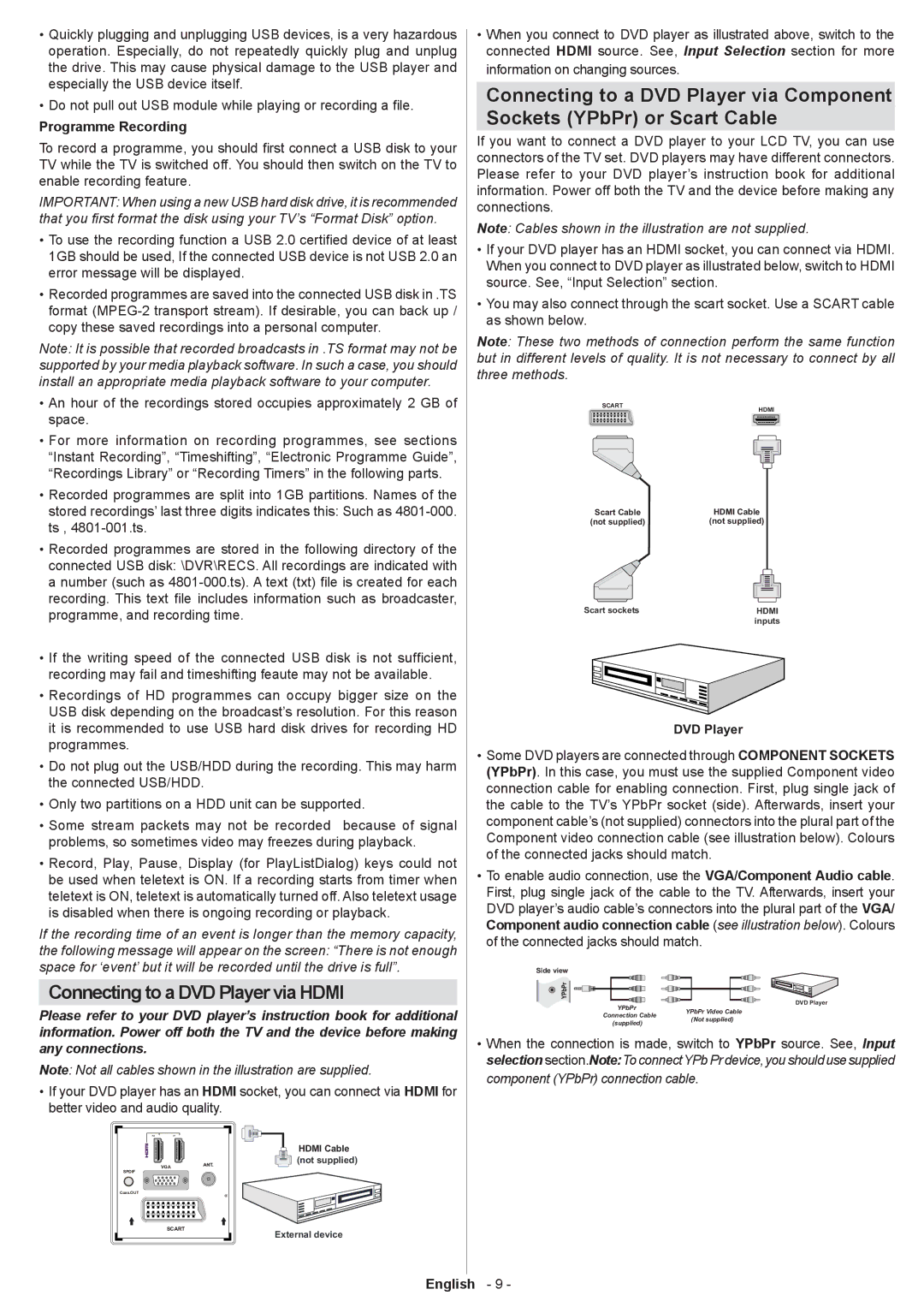
•Quickly plugging and unplugging USB devices, is a very hazardous operation. Especially, do not repeatedly quickly plug and unplug the drive. This may cause physical damage to the USB player and especially the USB device itself.
•Do not pull out USB module while playing or recording a file.
Programme Recording
To record a programme, you should first connect a USB disk to your TV while the TV is switched off. You should then switch on the TV to enable recording feature.
IMPORTANT: When using a new USB hard disk drive, it is recommended that you first format the disk using your TV’s “Format Disk” option.
•To use the recording function a USB 2.0 certified device of at least
1GB should be used, If the connected USB device is not USB 2.0 an error message will be displayed.
•Recorded programmes are saved into the connected USB disk in .TS format
Note: It is possible that recorded broadcasts in .TS format may not be supported by your media playback software. In such a case, you should install an appropriate media playback software to your computer.
•An hour of the recordings stored occupies approximately 2 GB of space.
•For more information on recording programmes, see sections “Instant Recording”, “Timeshifting”, “Electronic Programme Guide”, “Recordings Library” or “Recording Timers” in the following parts.
•Recorded programmes are split into 1GB partitions. Names of the stored recordings’ last three digits indicates this: Such as
•Recorded programmes are stored in the following directory of the connected USB disk: \DVR\RECS. All recordings are indicated with a number (such as
•If the writing speed of the connected USB disk is not sufficient, recording may fail and timeshifting feaute may not be available.
•Recordings of HD programmes can occupy bigger size on the
USB disk depending on the broadcast’s resolution. For this reason it is recommended to use USB hard disk drives for recording HD programmes.
•Do not plug out the USB/HDD during the recording. This may harm the connected USB/HDD.
•Only two partitions on a HDD unit can be supported.
•Some stream packets may not be recorded because of signal problems, so sometimes video may freezes during playback.
•Record, Play, Pause, Display (for PlayListDialog) keys could not be used when teletext is ON. If a recording starts from timer when teletext is ON, teletext is automatically turned off. Also teletext usage is disabled when there is ongoing recording or playback.
If the recording time of an event is longer than the memory capacity, the following message will appear on the screen: “There is not enough space for ‘event’ but it will be recorded until the drive is full”.
Connecting to a DVD Player via HDMI
Please refer to your DVD player’s instruction book for additional information. Power off both the TV and the device before making any connections.
Note: Not all cables shown in the illustration are supplied.
•If your DVD player has an HDMI socket, you can connect via HDMI for better video and audio quality.
2 | 1 |
|
|
| HDMI Cable |
| VGA | (not supplied) |
SPDIF |
| |
|
| |
Coax.OUT |
|
|
| SCART | External device |
|
|
•When you connect to DVD player as illustrated above, switch to the connected HDMI source. See, Input Selection section for more information on changing sources.
Connecting to a DVD Player via Component Sockets (YPbPr) or Scart Cable
If you want to connect a DVD player to your LCD TV, you can use connectors of the TV set. DVD players may have different connectors. Please refer to your DVD player’s instruction book for additional information. Power off both the TV and the device before making any connections.
Note: Cables shown in the illustration are not supplied.
•If your DVD player has an HDMI socket, you can connect via HDMI. When you connect to DVD player as illustrated below, switch to HDMI source. See, “Input Selection” section.
•You may also connect through the scart socket. Use a SCART cable as shown below.
Note: These two methods of connection perform the same function but in different levels of quality. It is not necessary to connect by all three methods.
SCART | HDMI |
|
Scart Cable | HDMI Cable |
(not supplied) | (not supplied) |
|
|
Scart sockets | HDMI |
| inputs |
DVD Player
•Some DVD players are connected through COMPONENT SOCKETS (YPbPr). In this case, you must use the supplied Component video connection cable for enabling connection. First, plug single jack of the cable to the TV’s YPbPr socket (side). Afterwards, insert your component cable’s (not supplied) connectors into the plural part of the
Component video connection cable (see illustration below). Colours of the connected jacks should match.
•To enable audio connection, use the VGA/Component Audio cable. First, plug single jack of the cable to the TV. Afterwards, insert your
DVD player’s audio cable’s connectors into the plural part of the VGA/ Component audio connection cable (see illustration below). Colours of the connected jacks should match.
Side view
YPbPr |
| DVD Player | |
YPbPr | Video Cable | ||
Connection Cable | |||
(Not | supplied) | ||
(supplied) | |||
|
|
•When the connection is made, switch to YPbPr source. See, Input selection section.Note:To connectYPb Pr device, you should use supplied component (YPbPr) connection cable.
English - 9 -
